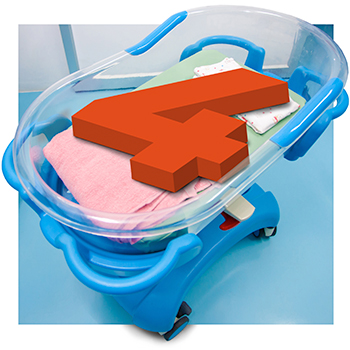
While many babies are born perfectly healthy, others have severe birth injuries that occurred in the womb or during labor or delivery. Birth injuries can also occur during the first month after birth, particularly if the newborn already has health problems.
Birth injuries can cause a variety of lifelong health problems and disabilities. These injuries have many different causes, including:
- Infection
- Placental abruption or insufficiency
- Premature birth
- Jaundice
- Sepsis
Sometimes these issues are unavoidable, while other times they are caused by medical malpractice during the pregnancy, labor, delivery or neonatal phase. Medical professionals sometimes fail to recognize problems or respond appropriately to protect the health of the fetus.
These are four of the most common types of birth injuries caused by medical malpractice.
Cerebral Palsy
There is currently no cure for this permanent disability, which can cause impaired motor function, weakened muscles and muscle spasms. Some people with cerebral palsy birth injuries can also experience seizures and impaired vision, speech or hearing as they get older.
This birth injury is caused by brain damage that could be the result of a premature birth or a lack of oxygen to the baby’s brain during the pregnancy, labor or delivery.
Medical professionals could be held liable for cerebral palsy if a claimant can prove that doctors and others involved in the pregnancy or delivery were negligent. Examples of negligence that can cause cerebral palsy include:
- Missing or ignoring signs that the fetus was not receiving enough oxygen
- Failing to notice that the fetus was tangled in the umbilical cord and losing oxygen
- Failing to diagnose or treat jaundice
- Not conducting a C-section when it is necessary
- Careless use of equipment to aid in the delivery
Brachial Plexus Injuries
The nerve network that begins in the upper spine and controls the muscles in the elbow, wrist, hand and shoulder is called the brachial plexus. Damage to these nerves can cause weakness or paralysis lasting anywhere from a few months to the rest of the child’s life, depending on the type of nerve damage:
- Neuropraxia is mild nerve damage that occurs when the brachial plexus is stretched.
- Neuroma involves tearing of the brachial plexus, which heals incorrectly.
- Avulsion results in complete paralysis, as the nerve roots are torn away from the spine.
- Rupture occurs when the brachial plexus nerves are torn. Surgery is required to promote healing of the nerves.
Brachial plexus injuries are often caused by the following forms of medical malpractice:
- Pulling too hard on the baby’s head or shoulders during the delivery
- Allowing a feet-first birth, even though these births have a higher risk of complications
- Misusing delivery aids, such as forceps or vacuums
- Failing to properly prepare for a difficult birth
Two common examples of brachial plexus injuries include:
Erb’s Palsy
This is often caused by damage to the nerves near the top of the brachial plexus. Erb’s palsy can cause the following medical issues:
- Weakness in the shoulders or arms
- Paralysis in the arm
- Loss of sensation in the arm
- Weak grip
Unless the injury is particularly severe, most victims make a full or close-to-full recovery within a year.
Klumpke’s Palsy
This injury is often a result of the baby being pulled out of the birth canal by an arm that is extended above his or her head, resulting in nerve damage in the lower brachial plexus. Symptoms of Klumpke’s palsy can include:
- Muscle atrophy
- Complete loss of feeling or sensation in the arm or hand
- Stiffness in joints
- Drooping eyelids on the opposite side of the face from the injury
Intracranial Hemorrhages
These injuries are also known as brain bleeds and can damage the nerves, spine and bones, in addition to the brain. Some of the most common types of brain bleed birth injuries include:
- Cerebral hemorrhage – This is bleeding in the brain caused by a stroke.
- Subarachnoid hemorrhage – This is bleeding that occurs between the two innermost membranes covering the brain.
- Intraventricular hemorrhage – This happens when there is bleeding into the ventricular system, where spinal fluid is produced.
- Subdural hemorrhage or subdural hematoma – This is bleeding from a ruptured blood vessel between the surface of the brain and the layer of tissue separating the brain from the skull.
Brain bleeds are sometimes caused by negligent medical professionals who:
- Failed to recognize an infection, such as Group B Streptococcus
- Were careless in their use of mechanical forces to aid in the delivery, such as traction or compression
- Failed to recognize cephalopelvic disproportion, where the infant’s head is too big to move through the mother’s pelvis
Birth Asphyxia
Birth asphyxia, or hypoxic ischemic encephalopathy, damages the infant’s brain as a result of oxygen deprivation around the infant’s delivery. Umbilical cord prolapse or compression, uterine rupture and placental abruption can all cause this birth injury.
This injury is preventable when fetal distress is accurately monitored and quick action is taken, such as an emergency C-section to free the infant.
Contact a Birth Injury Attorney Right Now
If your child sustained a birth injury due to a medical professional’s negligence, the birth injury attorneys of Janet, Janet & Suggs, LLC will pursue justice for your family.
We will fight to hold negligent healthcare professionals accountable for their actions while working to recover maximized compensation for your medical bills, lost wages, and pain and suffering. Contact us today for a free, no-obligation consultation.
RELATED POSTS
Our Lawyers Don’t Stop Fighting for Your Medical Malpractice Settlement Until Justice Is Served
Birth Injury Settlements
Iowa Verdict for Brain Injured Child
